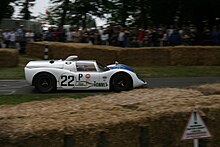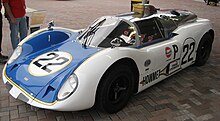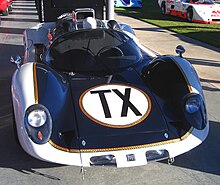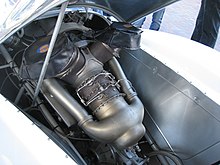Howmet TX
The Howmet TX ( T urbine e X perimental) was the prototype of a US racing car , the competitiveness of which was designed in 1968 gas-turbine-powered vehicles at sports car racing to investigate. The car planned by racing driver Ray Heppenstall combined a chassis built by McKee Engineering with a gas turbine leased from Continental Aviation & Engineering . The project was financially supported by Howmet Castings .
While the Howmet TX was not the first attempt to use a gas turbine in automobile racing, it was the first and so far only car to have won a race, two victories in Sports Car Club of America (SCCA) races and two qualifications in the only year he was entered in competitions. The TX was later six FIA - land speed record for gas turbine car on, after being withdrawn from the race.
development
Interest in the use of gas turbines instead of reciprocating engines in the automotive industry increased in the 1960s. Chrysler began testing in the 1950s and made its Turbine Car available to test customers in 1963, while British automaker Rover and racing team BRM worked together to build a racing car for the Le Mans 24 Hours of 1963 and 1965. Both cars were reliable, but couldn't win at Le Mans and neither did they convince the public. In 1967 the racing team owner and automobile developer Andy Granatelli had developed a gas turbine-powered roadster for the Indianapolis 500 , which almost won the race with Parnelli Jones as driver, but was eliminated after a lead over 2/3 of the race distance with mechanical problems. A similar attempt in 1968 with a Lotus 56 also led to failure, despite considerable potential for victory.
At the same time that Granatelli's turbo car made its first appearance in Indianapolis, racing driver Ray Heppenstall began to develop the design for his own sports car, improving the Rover BRM in a number of points where it had not been suitable a few years earlier had proven. Heppenstall figured that a simpler chassis design could make a turbine-powered car more competitive. Heppenstall originally tried to win the Allison Engine Company and later Williams International for his project. Then he turned to his racing colleague Tom Fleming for assistance. At the time, Fleming was vice president of Howmet Castings , a company that supplied turbine housings to the aircraft industry. Heppenstall and Fleming managed to convince Howmet that sponsoring a unique, competitive sports car could increase the company's public profile. Howmet agreed to support the project financially and to give the car her name.
landing gear
Heppenstall started the project with the purchase of a Cooper Monaco , but later decided that it would not be the first choice for installing a turbine and so the car was sold again. Bob McKee, owner of McKee Engineering, was then hired by Heppenstall to build two completely new cars. The first space frame chassis was taken from an older McKee car built in 1966 for the CanAm series and adapted to fit a turbine. The second car was completely redesigned so that it could be specially designed for the planned use of the turbine, and had a chassis that was 57 mm longer. The landing gear was called "Mark 9" by McKee, but was only used in races together with the turbine as Howmet TX.
The Mark 9 was tailored to the regulations of FIA Group 6 for sports car prototypes, with which a mid-engine design in an otherwise completely freely constructed chassis, which was only limited by a fixed engine size, was connected. The closed cockpit with double doors was designed by Bob McKee and clad the mid-engine chassis with the usual double wishbone suspension with coil springs and disc brakes on all wheels. A fuel tank with a capacity of 120 l was installed between the cockpit and the turbine and filled with Jet-A kerosene .
turbine
The turbines for the two Howmet TX were leased from Continental Aviation & Engineering . The TS325-1 gas turbines were prototypes from the company's tender application for a military helicopter, for which Continental had no other use at the time. The turbines weighed 77 kg, developed 325 bhp (239 kW) and delivered a torque of 850 Nm. The maximum speed was 57,000 min -1

The rear wheels of the Howmet TX were driven via a torque converter and a reduction gear. Because of the wide usable speed range of the turbine, a conventional gearbox was not required, so that the cars only had a single reduction. The reduction ratio in the differential could be changed quickly so that the cars could be adapted to different racing courses. So there was no reverse gear either. Heppenstall initially wanted to do without reverse gear at all, but the FIA insisted on a small electric motor driven by the turbine via a generator, with which the cars could be reversed.
The turbine itself had two large exhaust pipes that protruded from the rear of the car. A smaller third pipe for a wastegate was attached off-center. The wastegate was used to reduce the time lag between pressing the accelerator pedal and revving up the turbine. At maximum speed, the wastegate regulated the fuel supply, with which the turbine delivered more or less power.
Although the displacement of turbines cannot be measured as with piston engines, the FIA applied a formula and set the “displacement” of the Continental TS35-1 to 2,960 cm³. Heppenstall later stated that the engine actually exceeded the 3 liter limit. The Howmet TX was able to drive up to 3,000 cm³ in Group 6 in the prototype category.
Racing history
After completion, the two Howmet TX entered the Daytona 24-hour race , the opening race of the 1968 World Sports Car Championship . Even before the start, the TX attracted public interest because it was featured prominently on the cover of the racing program. Although both cars were available, only the younger was used in the race; the other was kept in reserve. Heppenstalls racing team, Dick Thompson and Ed Lowther were able to qualify with the seventh fastest race lap. Many competitors had to refuel early so that the Howmet TX could improve to third place, but on lap 34 the wastegate no longer opened, so the car was too fast for the curve. So the car skid and crashed into a barrier, so that the team had to give up.
At the 12-hour race at Sebring a few months later, the TX was able to improve and qualified third after a Porsche 907 and a Ford GT40 . At first the turbine ran without any problems, but at the start of the race it damaged parts of the debris so that it tore itself loose from its attachment. So the TX had to give up again after six hours. After Sebring, the World Sports Car Championship returned to Europe and the Howmet team took part. The car was registered at the BOAC 500 in Brands Hatch . Problems with the wastegate led to another accident, this time after just seven laps. The Howmet team stayed in the UK and entered the car in a sprint race at Oulton Park with British driver Hugh Dibley . Here the starter failed after a pit stop and the TX was again unable to finish the hour-long race.
Instead of staying in Europe for the remaining races of the World Sports Car Championship, the TX was brought back to the USA to participate in the SCCA National Championship. The problems were probably easier to deal with near home, as the car was able to complete its first race, the Vandergraft Trophy in New Cumberland, West Virginia . Heppenstall took second place with the car and set a new lap record. At a race in Michigan the Howmet TX dropped out again, but was able to finish the “Heart of Dixie” race in Huntsville (Alabama) . A short sprint race was held the day before the main race to set the starting grid. The Howmet TX won the sprint race, so it was able to start from pole position in the main race . So the TX was able to achieve a start-finish victory. These two victories were the first victories that a turbine-powered car had ever achieved in a competition.
After this first win for the Howmet TX, Heppenstall and Dick Thompson competed again in the Marlboro 300. Again the car won the short qualifying race for pole position and then the main race with a gap of 11 laps to the runner-up. The team now thought the car was ready to win European races and entered both TXs in the Watkins Glen 6-hour race , another race in the World Sports Car Championship. Hugh Dibley and newcomer Bob Tullius were in the first car, while Hoppenstall and Thompson drove the second. In the qualification, the cars took 8th and 9th place on the grid. After early accidents with the works Porsche , the Howmet TX took third and fourth place in the overall ranking. Dibley and Tullius' car had a transmission problem in the last hour of the race, so the car could only crawl around the track until the end of the race. The other car ran without problems and finished the race on the podium as the winner in its class. This place meant four points for Howmet in the sports car world championship.
After the success at Watkins Glen, the cars seemed ripe for a try at the 24 Hours of Le Mans , which had been rescheduled to September that year. The French aluminum manufacturer Pechiney sponsored the team's involvement in this race. The same drivers were used as at Watkins Glen, but the qualifying result at the Bugatti Circuit was worse because of the long straights. Twentieth place in qualifying was the best result of both cars.
Mechanical problems arose early in the race, and after three laps with Thompson's car. The fuel system was not injecting enough Jet-A kerosene for the turbine to reach its maximum output, so the car had to drag itself rather poorly than fairly along the long straights. While one car was driving around the course at a slower pace, the other two hours later suffered a broken suspension that required three hours of repairs. In the sixth hour the car was disqualified by the race management because it had only managed an insufficient race distance of 60 laps. The other car, which was still suffering from under-fueling, didn't make it much longer either, as Thompson had an accident on the Indianapolis corner and overturned the car, destroying it.
After the 1968 season, Heppenstall planned for the following year. Even a multi-stage gear instead of the single-stage reduction should be developed. But Howmet decided that the cars weren't doing enough to promote the company and ended the program.
Land speed records
Howmet decided in 1969 that although the racing program was too expensive, the two cars could still be used in advertising. Heppenstall decided to repair the chassis that had been destroyed in Le Mans the previous year. The car was fundamentally changed and received an open cockpit. It was then referred to as the Howmet TX Mark II . The new car broke several land speed records for turbine-powered vehicles. With a weight of around 1,000 kg, the car could break records in two classes by loading and unloading with ballast weights.
On a road near the Talladega Superspeedway , Heppenstall drove the TX Mark II to six FIA-recognized records and a new International Motor Sports Association (IMSA) time record .
| FIA speed records | ||||
|---|---|---|---|---|
| class | Type | Time sec. |
speed | |
| Class 2 (500-1,000 kg) |
Standing start, ¼ mile | 11.83 | 122.41 km / h | |
| Standing start, ½ km | 13.48 | 133.53 km / h | ||
| Standing start, 1 km | 21.18 | 167.97 km / h | ||
| Class 3 (over 1,000 kg) |
Standing start, ¼ mile | 13.87 | 104.41 km / h | |
| Standing start, ½ km | 15.74 | 114.35 km / h | ||
| Standing start, 1 km | 23.92 | 150.50 km / h | ||
Later use

In 1971 Howmet stopped using the two vehicles for corporate advertising. Both chassis were sold to Ray Heppenstall for US $ 1. However, since the turbines were only leased from Continental, they had to be returned to the company as soon as the cars were no longer in use for Howmet. Heppenstall later sold both chassis.
Chassis # GTP1 bought Jim Brucker and added it to his personal collection in California. It was on display and had a mock-up of a Continental turbine built into it. In 2006 the car was bought by Bruce Linsmeyer from Avon Aero and an original Continental turbine was installed. After the restoration, chassis # GTP1 won the Sebring Trophy at the Concours d'Elegance 2007 in Amelia Island .
The second car, chassis # GTP2, was converted from the open cockpit back to the original, closed cockpit by McKee Engineering at the instigation of the new owner, Chuck Haines. An original Continental turbine was no longer available; so a smaller Allison 250C18 was installed. The other drive required some design changes, since the exhaust pipes do not exit the turbine upwards, but to the rear. The wastegate was no longer needed, so the third exhaust pipe was no longer necessary either. Chassis # GTP2 was completed in July 1996 and has competed three times at the Goodwood Festival of Speed . It was later sold to Xavier Mocheron and is now on display in France.
While Haines owned the # GTP2 chassis, a half-finished McKee Mark 9 chassis was discovered. This third chassis, # GTP3, was also bought by Haines. In 2000 McKee built a third car based on the original specification for Haines. Again, an Allison engine was installed instead of the Continental turbine. Haines still owns chassis # GTP3 and uses the car in historic motorsport, including in 2007 at the Goodwood Festival of Speed.
Web links
- Howmet TX # GTP2 at the start of the Concours d'Élegance on Amelia Island, YouTube
- endurance-series.com Article about Howmet TX (French) ( Memento from December 25, 2008 in the Internet Archive )
Individual evidence
- ↑ a b c d e f g h i j k l m n o p q r s t The History of Howmet TX Turbine Car of 1968, still the World's only Turbine Powered Race Winner , Pete Stowe's MotorSport History (2006) ( Memento dated March 2, 2008 in the Internet Archive )
- ↑ a b c US National Races 1968 , World Sports Racing Prototypes, October 2, 2005
- ^ Chrysler Turbine Engines and Cars , Allpar
- ^ The Rover Turbine Cars , The Rover Club of Auckland
- ↑ a b c d e f g h i j k l m n o Diepraam, Mattijs: The Rise and Fall of Alternative Power in Motor Racing - Swoosh and Screech! - Part 1: Aircraft on Asphalt , 8W, May 19, 2003
- ↑ Blunk, Frank M .: Fate Rides Shotgun , New York Times, May 31, 1967
- ↑ a b c d e f g h Transcripts: Ray Heppenstall , International Motor Racing Research Center, July 10, 2000 ( Memento of July 9, 2008 in the Internet Archive )
- ↑ a b c McKee Chassis Numbers , World Sports Racing Prototypes, January 31, 2006
- ↑ a b c d e f 1968 Howmet TX , ultimatecarpage.com, July 3, 2006
- ↑ Daytona 24 Hours 1968 , Racing Sports Cars, April 25, 2006
- ↑ a b c d e f International Championship of Makers 1968 , World Sports Racing Prototypes, October 2, 2005
- ^ Sebring 12 Hours 1968 , Racing Sports Cars, September 28, 2006
- ^ Brands Hatch 6 Hours 1968 , Racing Sports Cars, December 7, 2005
- ^ Howmet Turbine , Avon Aero, Inc. (2007) ( Memento of March 2, 2008 in the Internet Archive )
- ↑ About CanAm Cars , CanAm Cars Ltd.


